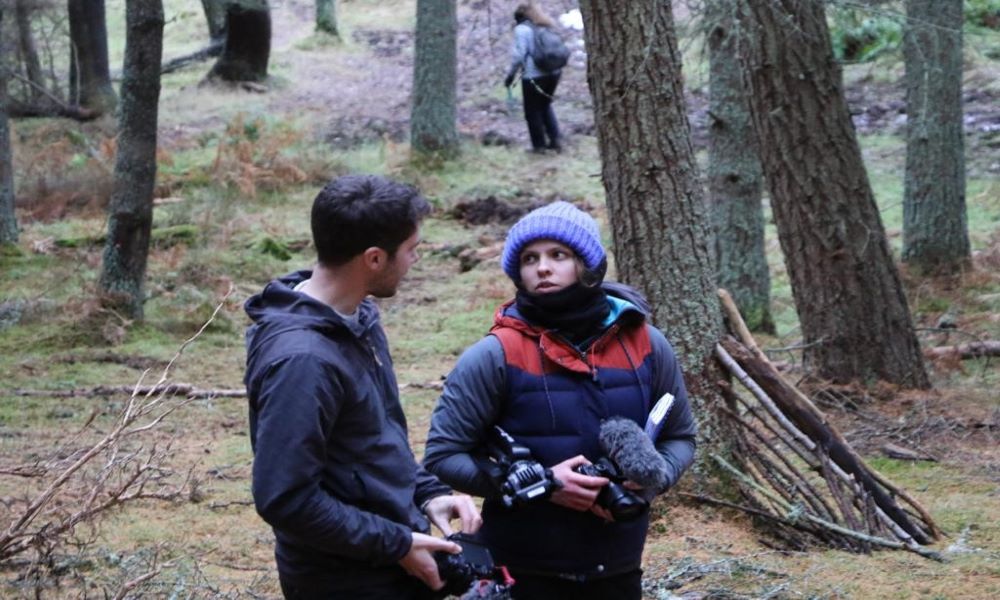
In this post, recent MSc in Outdoor Education graduates Catherine Dunn and Jack Reed describe the value of digital storytelling for higher education and how it has the power to address intersectional socio-cultural and environmental issues to great effect…
Digital Storytelling in Higher Education
Storytelling is a fundamental part of both formal and informal education. Stories are how we form, maintain and change culture, how we relate to one another and how we understand the most complex issues we encounter as humans. In higher education storytelling is a profoundly important way of contextualising learning in real-world experience. Yet, often these stories fail to reach beyond the four walls of the classroom. So, how can we further the reach of our stories?
Digital storytelling
Digital storytelling can take on a number of definitions under the umbrella of creatively constructed, technology based storytelling, but for the purposes of this discussion we will refer to digital storytelling in the context of filmmaking. Telling stories through film is no new concept and can be seen in everything from traditional cinema, television and the news media, to TikTok, Instagram and YouTube. Using increasingly accessible technologies, such as mobile phones, digital storytelling in higher education allows students greater input in the narrative process and greater ownership over their learning. Additionally, it also serves as a highly effective facilitatory tool for unpacking complex real-world issues.
Why is digital storytelling important?
“When facts become so widely available and instantly accessible, each one becomes less valuable” (Pink, 2005, p. 103). What Pink aptly describes in this quote is the state of information-overload many of us live with on a day-to-basis, where an avalanche of stories, facts and opinions are not only at our fingertips, but are imposed upon us by our ever expanding digital ecosystems. So, why should higher education be adding yet more content to an already imposing digital landscape?
Disentangling complex issues
It’s important to acknowledge how empowering the process of storytelling is. On an individual level, the process of producing a digital story can help learners disentangle their own complex digital ecosystems; a heightened awareness of who the storyteller is and how digital stories are produced can often help people process and filter information-overload. On a collective level, viewing a digital story can help disentangle and address complex socio-cultural and environmental issues by centralising people and places in relation to lived experience. Indeed, Pink (2005, p. 103) adds, “what begins to matter more is the ability to place these [stories] in context and to deliver them with emotional impact”. For example, the creation of a short ‘talking heads’ style film in which learners discuss their experience of colonialism in higher education would be a profound way of disentangling the inherently complex and intersectional issues around decolonising the curriculum. Moreover, it could do so while avoiding the information-overload and context-less stories which drip from the saturated branches of our digital ecosystems.
Stretching the boundaries of storytelling
The reach of any given story is bound by its ability to capture the imagination, interest and engagement of an audience. Written words, images and spoken word are all important ways of storytelling. However, when sharing stories from higher education they often lack the ability to reach into virtual communities and establish emotional and real-world connections. Education has the profound ability to affect change in areas of socio-cultural and environmental challenge and the digital stories which learners and staff can individually or collectively create can instigate far-reaching conversations and challenge normalised ways of thinking. For example, a group of learners and their facilitator may create a short film about their experiences as women in higher education. By releasing such a film on social media, not only could it physically reach a much larger and more diverse audience than a written story, but it could provide a physical representation of women in an otherwise highly gendered online space. As this example demonstrates, digital storytelling presents higher education with the opportunity to leapfrog traditional constraints around representation that marginalised populations may face. Importantly, this would enable a much broader and more diverse reach, allowing higher education to approach inherently intersectional socio-cultural and environmental issues to far great effect.
‘I’m just talking to the camera’
The much maligned categorisations of ‘millennial’ and ‘generation z’, used broadly to describe young adults who grew up in the early 21st century, are often associated with formative digital storytelling on platforms such as YouTube. Much criticism is angled at these so-called entitled generations of ‘digital natives’ for our story-saturated digital ecosystems. Yet, for a generation who have recently/are currently navigating the world of higher education, digital storytelling has offered them a collective voice in addressing global socio-cultural and environmental issues.

It has worked to great effect with social movements such as #MeToo, #BlackLivesMatter and #HeForShe growing exponentially online. Surely it is time that higher education sought to harness the power of digital storytelling at the curricula level.

#DearOak
#DearOak is an example of digital storytelling produced collectively by students and staff from the Outdoor Environmental Education programmes at the University of Edinburgh. Based on an encounter with an oak tree during a place-based residential learning experience, this short film represents explorations of self, of nature and of global environmental and ecological concerns. It is an example of how higher education can harness the power of digital storytelling, empower students and reach well beyond the walls of the classroom. Watch the film here: https://youtu.be/tHTuY8UBCCE
Note: If you would like to know more about the outcomes of this film, please read Digital spaces and outdoor places: Unbundling traditional structures of the university.
References
Pink, D. H. (2005). A whole new mind: Moving from the information age to the conceptual age. New York: Riverhead Books.


 Jack Reed
Jack Reed
[…] Digital storytelling in higher education, from the University of Edinburgh. […]